Review and photos by Lanthanotus, edited by Suspsy
A few months ago I stumbled upon pictures of several dinosaur figures made by the French company Starlux while I was reading through the “Recent Acquisitions” thread in the DTF. I looked up this company and found that they had made a great array of dinosaurs as well as some very obscure and rarely depicted prehistoric animals. The overall quality in regards of accuracy, however, ranged from poor to more or less decent. Some of this could be excused by the time that the figures were made (from 1969 onwards), when technical limitations as well as outdated or unsufficient reconstructions made accurate modelling a hard job, especially when the aim was to produce a somewhat cheap toy. Despite the often poor accuracy and detailing, Starlux figures boast a certain charm, and at least some of them are great in terms of both detailing and accuracy. Let me introduce you to two examples.
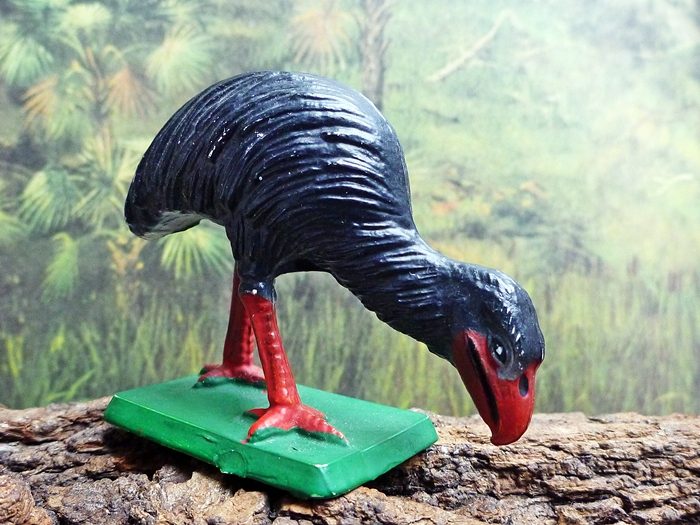
Today, Diatryma is considered a species of the genus Gastornis, but back in 1970, when this figure was released, Diatryma was a valid taxon. Gastornis species dwelled in Europe, North America, and China during the Cenozoic era, around 56 to 45 MYA. The flightless birds grew up to 2 metres tall and were long considered to be carnivorous, hunting small mammals such as the early ancestors of our modern horses. That kind of diet was under discussion for years and recent studies of the calcium isotopes in Gastornis bones suggest that it actually lived a vegetarian’s life.

Starlux’s rendition of this enormous flightless bird is outdated, yet quite accurate for its time and in comparison with other Starlux figures. The bird is covered in a thick, shaggy coat of hair-like feathers, similar to those seen in today’s ratites. But this is a feature that has been deemed incorrect, as what was formerly thought to be fossilized feathers were really plant fibers. Isolated fossils of broad, vaned contour feathers have since been found and are probably related to Gastornis, so its plumage was probably smoother like that of most living birds. Wings are not visible as Gastornis‘ wings were greatly reduced and were probably not visible under its feathers. The figure’s head is as big as it should be and so is its beak. The hooked tip of the beak is incorrect though, and while the beak may also be too broad, the lower mandible is as deep as it should be. The legs appear thinner than in most renditions of the species, but are probably correct when compared with modern flightless birds. The feet, however, have a somewhat weird, cross-like appearance where all the toes(digits I to IV) are arranged in 90 degree angles to each other. This include the hallux (digit I), which is shown as a fully developed, weight-bearing toe, while in fact it was greatly reduced and placed a good deal above the ground. This feature, however, may be a concession to stability in the figure. Starlux’s Diatryma is shown in a hunched-over stance as if it was picking around for something on the ground. The remains of a poor, slaughtered equine perhaps. Or for more modern renditions, nuts or fruits. The figure stands 4.2 cm tall including the base and seems to be more robust than the thin legs and the inflexible plastic may suggest.
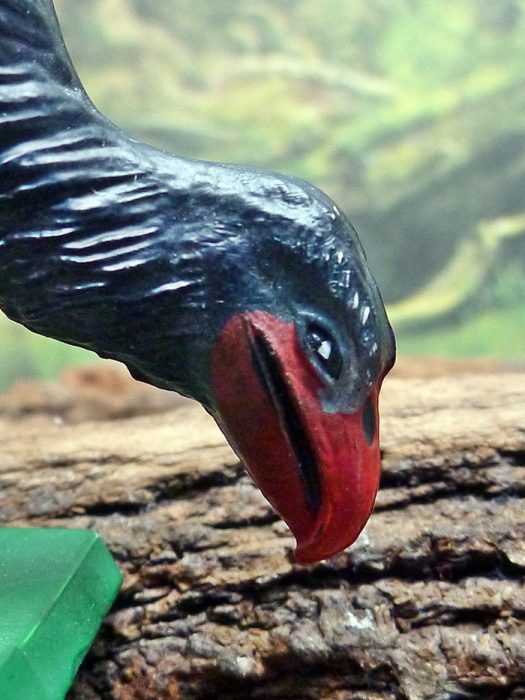
The second figure of this review is a model of the famous terror bird Phorusracos, although it seems Starlux may have made a mistake with the name, as the figure is listed as “Phororacos” in the Toy Animal database as well as frequently on eBay France where I got mine. Phorusracos was a monotypic species of the Patagonian Miocene, 20 to 13 mya. This giant flightless bird grew even taller than Gastornis (up to 2.5 metres) and lived a predatory lifestyle. The bird boasted a long skull with a strong, hooked beak and long legs ending in sharp claws.
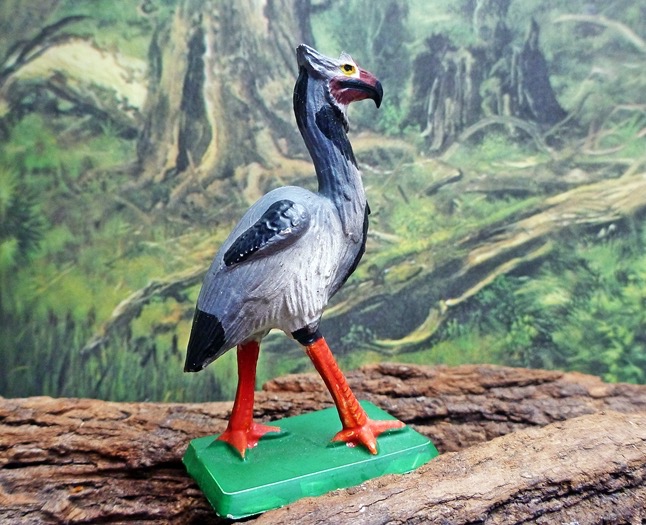
The Phorusrhacos stands 6.5 cm tall and is depicted in a fully erect stance. While this posture may natural and correct, the hump on the steep back looks quite awkward. The small wings are clearly visible but are placed too far towards the back. The bird seems to be coated in a variety of feathers. The wings show a small array of contour feathers, the tail feathers as well as the ones surrounding the head seem to be neatly arranged (and are therefore also contour feathers with strong vanes), and the remaining part of the neck and the body seem to be covered in hair-like feathers.
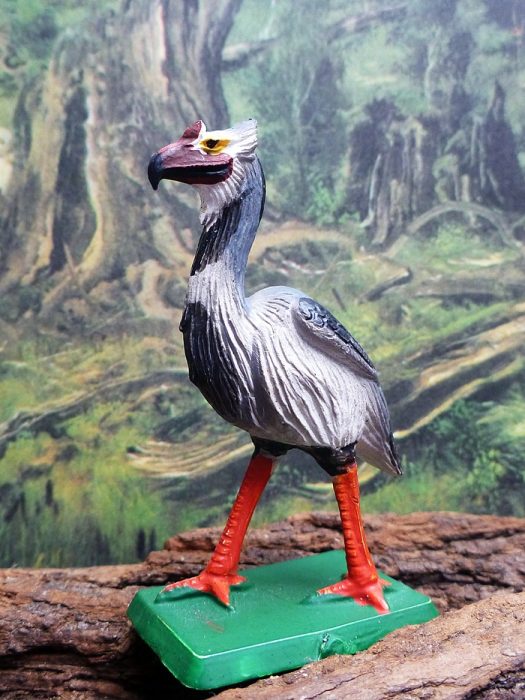
The head is finely sculpted with a mean, raptor-like expression. The strongly accented eyes as well as the brows add to this effect. The feet and legs appear to be the same as in the Diatryma, but the latter are slightly longer in this figure. The paint job in this model is way more attractive than the Diatryma. The green of the base is a bit sloppily applied in both models, leaving the feet poorly painted, but overall, the paint job is acceptable.
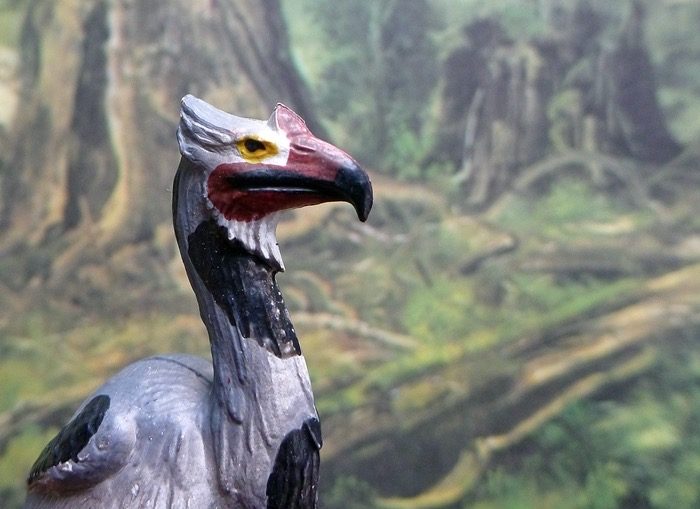
Despite some inaccuracies, I highly recommend both these figures to any collector of the post-Mesozoic megafauna, especially as the selection of prehistoric birds is very limited due to a lack of attention by toy and model makers (though this is most likely related to a lack of interest by customers). Both figures are long out of production but can easily be found on eBay for a few Euros.
Disclaimer: links to Ebay and Amazon on the DinoToyBlog are affiliate links, so we make a small commission if you use them. Thanks for supporting us!




“The bird is covered in a thick, shaggy coat of hair-like feathers, similar to those seen in today’s ratites. But this is a feature that has been deemed incorrect, as what was formerly thought to be fossilized feathers were really plant fibers.”
Aha! Proof that Gastornis had scaly skin!
😉
“The bird seems to be coated in a variety of feathers… the remaining part of the neck and the body seem to be covered in hair-like feathers.”
I’m not sure if you approve or not, but I like the effect. It reminds me of certain extant birds, like the Nicobar pigeon, or the display feathers of some of the bustards.
“Aha! Proof that Gastornis had scaly skin!” Haha, that would be indeed one of a kind, could make a nice restoration model though 😀
I cannot say if the sculptor intended the Phorusracos to display several kind of feathers, hard to achieve and even harder to tell at that scale. It would certainly be a strange and rare feature in birds, but overall I like both figures and probably could hardly any modern toy company improve them much in that scale I suppose.